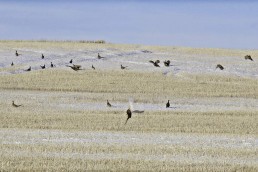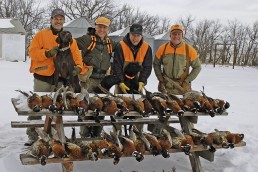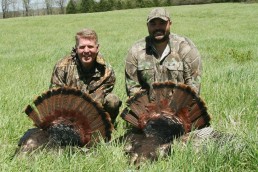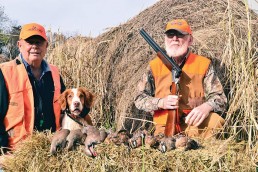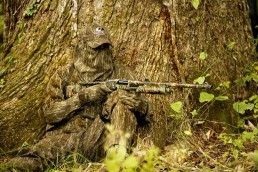The Pinch and Follow-up Flushes
SHARE THIS POST
Leaving from our rental farmhouse and driving along the Enchanted Highway in western North Dakota, the landscape looked like a research station in Antarctica. This was during the final days of what had become winter pheasant season, and the winds the local TV forecasters described as “breezy” were doing a good job of producing a sweeping white mist that kept all but weirdos like us at home clutching a hot chocolate.
This is a land dominated by pay-to-play hunting opportunities, but John Maloney, who was driving us out to the first spot, is one of the finest permission-askers of all time. And through a series of connections and superb diplomacy, we had some good stuff to go through free of charge. As we moved down the road, impressive bunches of birds could be seen hanging in farm groves and pecking around in waste grain stashes—but in most or all of those areas there were also signs indicating that you could hunt if you got out your wallet.
Call us stubborn holdouts, but we have yet to crack under the pressure, using the time-honored art of conversation and respect in exchange for a chance to shoot a few birds. It was obvious this was not going to be easy, and we knew that going in. In fact, the discussion in the cab of John’s pickup was fairly predictable; he reminded us that, in his opinion, most or even all of the birds we would shoot would not come on the first flush. He, much more than I, stops what he’s doing when a rooster is flying away in the distance, watching exactly where it lands and then planning a precision move on the same bird. The assumption is that pheasants, even though they have impressive flight muscles, are less inclined to flush wild on the second go.
It’s effective strategy, but one that I am not very good at. Commonly, as John will be saying something like, “There, did you see where he landed?” I will have lost sight of the bird long ago. I do listen carefully to him—when the two of us cross paths out in the cover, both following our dogs—whenever he reports the location of a previously-flushed rooster. I have to admit, it’s solid strategy at any time of year, but really makes a difference in the late season.
Riding beside John in the front passenger seat was another of our good friends, Bob Johnson, a veteran hunting dog breeder and trainer. He is known for the quality of his labs, and always has an amazing animal to hunt over, which he can control like a precision heat-seeking missile. Johnson is an intense hunter who thinks bird season every day of the year, and interwoven with John’s talk about follow-up flushes, Bob was laying out his thoughts on how we could best use the moving pieces at our disposal to increase the odds for success.
“It’ll be all about the pinch,” Bob said. “Those birds have to feel the pressure coming from multiple directions.” We could do that, because we also were hunting with friend Jim Helseth, so we had four guys and three dogs, a good squad for executing calculated moves.
Throughout parts of the last four days of North Dakota’s season, we hunted a patchwork of public (Private Land Open to Sportsmen, or PLOTS) and private ground. Even though there were an extreme number of hens, we orchestrated high quality shooting every day. Our strategy was remarkably similar in most spots: there was almost always a tree grove of some kind associated with the place, and we’d surround it as best we could, showing ourselves on the sides we did not want birds to pour out of. Using the dogs to run around in there and send pheasants sailing, we did our best to influence them to fly out into the cover we had permission to hunt.
Shocker: it didn’t always work perfectly. But in most cases, huntable numbers of cock birds settled into tracts of CRP, creek bottoms, sloughs and other stuff we could then walk. Because we have hunted together for many years, we could spot each other out in the cover and work multiple pinching maneuvers without having to yell or even wave. When pinches were not presented, we simply let our dogs do what they were born to do. That’s our favorite aspect, going along for the ride behind a dog’s nose, wherever it takes us, and trying not to screw up the shots.
Are you enjoying this post?
You can be among the first to get the latest info on where to go, what to use and how to use it!
Hour after hour, it was time well spent.
Walking was a challenge where winds had piled up deep snow, but in numerous cases the snow worked to our advantage, with roosters attempting to hold as we walked by. When you’re hunting over a good dog, that is often a bird’s final mistake. On the first morning, in fact, my shorthair, AJ, found a series of roosters hunkered in sparse and snow-blown cover. He kept finding birds one at a time, slipping back downwind and circling up into the same general area before locating and pointing another one.
The first rooster lucked out, flying low straight away, using the dog as a shield, and I couldn’t shoot until the bird was out of range. The second bird had no such luck and we put him in the game bag. AJ pointed another one and this time he dove into the cover as I was kicking in front of his nose and grabbed the rooster before it could fly. The bird was flapping its wings against both sides of AJ’s head, so I came to the rescue, setting my gun down to take it from him.
There was a moment when neither of us had a good grip and next thing we knew the bird was flying away. I made a very smooth move over to my gun and fired two shots into orbit. John would have been able to tell me where the bird eventually lit, but I had no idea. AJ put the matter out of his mind immediately, circled around, and was back on point within a minute. I shot another beautiful rooster that flushed from under his chin and we only had one to go.
As I was telling my cool tale to Bob and Jim, who were sitting in the truck when I got there, I mentioned that I should have had three for sure.
“Sounds like you shoulda had four,” said Bob, in his classic deadpan hunt camp smack, followed by a good laugh.
It was no surprise to hear that both those guys already had their three birds. John and I each needed one, which we picked up at the second spot, and by noon we had our 12 and were driving around setting up other places for the following days.
It went like that for four days (including the verbal jabs back and forth). In the end we had 43 birds in the back of the truck, all earned one at a time. We could and should have had more, but we’ll leave out some of the details for now. Besides, it was more than enough, and a good reminder that late-season bird hunting is a challenge, but totally doable. Especially when you follow John and Bob’s advice. It’s all about the pinch, and follow-up flushes.
MWO
SHARE THIS POST
Did you enjoy this post?
You can be among the first to get the latest info on where to go, what to use and how to use it!
Mark Strand
MidWest Outdoors editorial director Mark Strand is a graduate of University of Minnesota School of Journalism with a minor in Fisheries & Wildlife Science. He has written for nearly every outdoor magazine over the past 41 years, and has written or co-written 14 books. In addition to writing and photography, Strand produces the MidWest Outdoors Podcast, and contributes to MWO digital properties. He is an outdoor generalist who loves hunting and fishing of all types. In 2018 Strand was elected to the Minnesota Fishing Hall of Fame.
